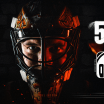Ian Anderson, the Flyers director of hockey analytics, was recently Jason Myrtetus' guest on the Flyers Daily podcast. Anderson discussed a wide array of topics, including the evolution of analytics, how data is procured and, in basic terms, how the data is put to use within the hockey operations segments of the organization.
Analytically Speaking: How the Flyers Collect and Use Hockey Data
Ian Anderson, the Flyers director of hockey analytics, was recently Jason Myrtetus' guest on the Flyers Daily podcast.

Over the past eight years, the Flyers use of analytics has grown to the point that there is now an analytics department consisting of five full-time employees including two new hires. Anderson explained to Myrtetus how each data analyst on staff has his or her own area of specialization; much like a hockey club itself is constructed with players who perform different roles but work together in combination toward the success of the team.
Analytics Evolution
According to Anderson, the widespread use of data analysis in the NHL is still a relatively recent phenomenon. His first job in the NHL had nothing to do with hockey statistics.
"I was hired by the Washington Capitals in 2007-08 in a team operations role. Over the course of nearly seven years with the organization, I realized that we weren't doing any data analysis. Not just the Capitals; any team. The lightbulb went off in my head, and I started asking a lot of questions. I asked, 'Why don't I do this?' I can bring this to the table," Anderson recalled to Myrtetus.
Although there was no "analytics" sub-specialty in hockey, some teams tracked specific stats by hand on an ad hoc basis.
Back in the 1980s, the late EJ McGuire painstakingly went through entire game films for the purpose of recording shift times and the total ice time for every player on the team. He spent hours pausing and rewinding video cassette tape to track the elapsed time from when each player in the lineup entered and exited the ice on each shift.
The job was performed with a TV set, Betamax/ VCR, a stopwatch, and a notepad. McGuire tracked individual shifts and then generated a total amount of ice time for each player
When the task was completed, the longtime assistant coach wrote out the hand-compiled player-by-player ice time data and passed it along to head coach Mike Keenan. McGuire performed this task for Keenan with the American Hockey League's Rochester Americans and later for the Philadelphia Flyers and Chicago Blackhawks.
"Edge was more of a stat keeper than I was," Keenan said in 2015, referring to McGuire (who passed away in 2011) by his nickname. "Maybe it's because he was an American and influenced by baseball, which has always been the most stat-oriented sport. But he'd track the ice times and look at some other stat things he could compile for us to compare with what we saw on the ice. It's just of the things he brought to our staff."
Long before there was an "analytics" specialty of data analysis in professional hockey, the work that McGuire did for Keenan was innovative (and proprietary) for its era. It was the first baby step taken within the Philadelphia Flyers organization toward data tracking that went beyond the individual goals, assists, points and penalty minutes officially tracked by the league.
Years later, former NHL goaltender and goaltending coach Jim Corsi became another one of the early innovators in statistical record keeping and analysis. In the early 2000s, Buffalo Sabres goalie coach Corsi hand-tracked shot attempts -- ones that got on net, ones that got blocked, and ones that missed the net or hit the post.
The statistic, which was later named for its creator, became a rudimentary proxy for tracking puck possession for the two teams on the ice and something that could tracked in the public sphere. Rather than being a plus-minus of goals, it was essentially a plus-minus of shot attempts that could be looked at for 5-on-5, power plays, penalty kills, etc. Over time, the stat was refined in order to look at factors such as the score and time of the game, as well as the venue.
Today, there are much more sophisticated ways than Corsi -- both in the public sphere and on a proprietary basis -- of tracking and analyzing puck possession. The emphasis moved from quantity of shot attempts and possession to the quality of scoring opportunities created.
However, Corsi and Fenwick stats (the latter narrows the focus to unblocked shot attempts) for individual players and teams are readily available and still widely used within the media. They're still called "advanced stats", although that term is a misnomer. The stats are actually rather simple to understand at a glance. Their simplicity, in fact, is actually the key to their still-enduring appeal.
Anderson said that the NHL made its first steps into leaguewide data collection starting in the first decade of the 2000s. In addition to box score summaries (goals, penalties, power plays, basic goalie stats), the league implemented a real-time tracking system for game events; both objective stats (shots on goal, blocked shots, missed shot, faceoff wins and losses) and stats that were a bit more subjective (such as hits, giveaways, takeaways). This data is available on NHL.com for every game played in the league. It is updated regularly within a game and then finalized.
"This is stuff everyone is familiar with. This type of game-level data is about 350 to 400 events per game; basically 400 rows of data in an Excel file," Anderson said.
Although the event summary data was available, few if any NHL teams analyzed it in the early years. Thus, as Anderson's role evolved within the Capitals organization, it became his task to track the information.
Anderson joined the Flyers' organization in 2014.There wasn't an analytics department; it was still a one-person job but the task was growing into something that required a dedicated full-time employee to collect and analyze.
"Around 2014, when I came to the Flyers, the reason I came here, there were a couple of third-party vendors that produced software for event-based tracking by using video. That could give you a lot more granular detail such as who was carrying the puck. Where did they start (on the ice)? Where did they end? Was it an entry? Was it a pass? What type of pass? So now you go from about 400 game-level events per game to about 4,000 events," Anderson said.
One Link in the Chain
With more and more game-event data available, the challenge grew to separate useful information that could arm members of the organization to help their jobs a little better. Leaguwide, the job became more and more specialized and complex, requiring the creation of analytics departments to create a variety of in-house metrics.
It's all geared toward assisting the end users: The head and assistant coaches, the general manager, assistant GM and staff such as a scouting director or director of player personnel (titles and exact job details can differ slightly by organization).
For example, a coach could use data supplied by Analytics to compare specific metrics of interest to what he saw with his own eyes on the bench and on video. Did the coach's eyes tell him that Player A is strong in the trenches but weaker in puckhandling? Normally, the data back it up. If the information differs from the eye test, however, the coach may opt to go back to the video and try to pinpoint the reason for the discrepancy.
Likewise, data from upcoming opponents could be used in conjunction with video and first-hand prescouting reports as part of the preparation process for the game. What are the opponent's tendencies? Who has been playing well (beyond recent goals and assists) of late? Who may be struggling and vulnerable to being attacked on the forecheck? What adjustments has the rival team made recently? Have they been successful?
Anderson said, "We've been doing prescouting for years. There's an element of analyzing other teams. There's also analyzing our team and our players. Similarities and differences of teams and players that are good or bad in certain areas. What sort of things teams are having success in doing and working backwards from that to look at what they're doing to achieve those results."
Many NHL organizations nowadays, including the Flyers, have added other highly specialized departments. They, too, work in conjunction with Analytics.
"The very first thing that you need to do is approach it from almost a consulting standpoint. Go to the key stakeholders within an organization -- the coaches, the specialists, the development people on the ice -- and ask them questions," Anderson said.
" We have experts in their field within our organization. We have experts in goaltending (goalie coach Kim Dillabaugh and goalie development coach Brady Robinson]. We have an expert in strength and conditioning. Go to those people and ask, 'What are the things that are important to you? What are things you want to know more about?' It's my job and my staff's job to take that input back to our own work to find ways to assist them."
Recently promoted from Pro Scout to becoming the Flyers new Director of Player Personnel, Alyn McCauley confirmed on Flyers Daily that he plans to incorporate elements of statistical information supplied by Analytics to information gleaned by traditional means.It is still vital to observe players through direct scouting. Nowadays, this is supplemented not only by video study but also by technology that can be applied to examining a variety of different areas of player performance.
Anderson said that the success of any Analytics department depends on how seamlessly their work can be tailored to meet the various end users' needs. In turn, each facet within Hockey Operations has to fit together to everyone's benefit.
"We are one link in the chain. If we're not providing them with information they want and can use, that whole chain breaks down," Anderson said." It's no different than building a team and line combinations; different skills, roles and attributes that you need to make the team more successful. Everyone has their particular strengths they contribute."
A Massive New Challenge
Beginning at the start of the 2021-22 season, the NHL implemented a much more sophisticated form of tracking players and game play. On Flyers Daily, Anderson broke down some of the basics.
"Every player in the league wears an RFID (radio-frequency identification) chip and there are cameras that pick it up multiple times per second. There's one in the puck as well. Now, there's over one million game-level events generated," Anderson said.
To summarize, the league has gone from collecting roughly 400 events per game to 4,000 and now more than 1,000,000. It's up to each NHL organization separate the wheat from the chaff and find how it can be applied on a day-to-day basis to gain a competitive advantage.
"The data dump is a huge challenge from a computer standpoint, from a manpower standpoint. We need to figure out what's important and what's not important. Some things we can pull out immediately or fairly quickly to help the Flyers organization. Other things will take years to develop. It's a massive forest, and we need to figure out our way through the forest. to do something meaningful fairly quickly," Anderson said.
"This is part of something we're trying to accomplish as an entire organization, Again, we're just one link of that chain."
Recently, the Flyers hired two new full-time hockey information analysts, bring the staff to five employees. New hires Cole Anderson and Kathryn (Katie) Yates have joined Assistant Director of Hockey Analytics Jacob Hurlbut, and hockey data analyst Matt Karliner as data analysts on the staff headed by Ian Anderson.
Cole Anderson is a data scientist by trade but also a former collegiate hockey goalie at Amherst and a still-active coach at the lower levels. For the Flyers, unsurprisingly, he will focus on data that related to goaltenders.
"Cole has spent years studying and analyzing goaltending. He's developed proprietary metrics that are now publicly accepted by a lot of people. He's looked at things like rebounds, expected goals above or below replacement that are now in the public domain, He's one of the people who were at the forefront of doing that," Ian Anderson said.
"Cole has really good technical skills. But he's also a former goalie who knows the position and how it incorporates with being part of the team. He has a great knowledge of the game through both sides" the analyst side but also the player and coach side. He coaches the game at lower levels. Actually, when he was playing, he was a student at one of the camps run by our goalie coach, Kim Dillabaugh"
Yates also has an impressive background in incorporating hockey data into team operations.
"Katie's been part of the UMass program that just won the National Championship. She's getting her second masters. She's worked for the Boston Bruins and she's a young woman. Her work ethic is off the charts and talk about multi-tasking. She's got all these things going on. She comes very highly recommended from Greg Carvel at UMass as well as from the Boston Bruins. We're excited to get her in here in the spring after UMass' season is done," Flyers general manager Chuck Fletcher said.
"Ian and Jake have been here a long time while we added Matt a couple seasons ago on the analyst side. They've been doing great work, but we're now getting this massive data dump from the NHL. There's going to be incredible opportunities for teams to try to figure out how to manipulate and best utilize the data that we're going to have. We're trying to get ahead of it. Katie and Cole are two tremendous hires. Ian did a great job going through the process. We had hundreds of applications. These two young people, we're very fortunate to hire them."


















